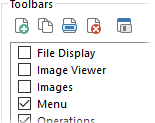
The Toolbars page displays a list of all your toolbars, and lets you create
new ones, delete existing ones, and turn them on or off. You can also change
various appearance settings for individual toolbars from this
page.

The checkboxes indicate whether a toolbar is currently turned on or off. Use
the toolbar buttons to manipulate the toolbars:  (create a new
toolbar),
(create a new
toolbar),  (duplicate an existing toolbar),
(duplicate an existing toolbar),
 (rename toolbar),
(rename toolbar),  (delete toolbar) and
(delete toolbar) and  (float toolbar). Note that the
default toolbars cannot
be deleted or renamed. The Reset to Defaults command only
applies when one of the default toolbars is selected.
(float toolbar). Note that the
default toolbars cannot
be deleted or renamed. The Reset to Defaults command only
applies when one of the default toolbars is selected.
When you select a toolbar from the list (and it is turned on), you are able to edit a number of settings on the right-hand side of the page. These are grouped into two sections.
The Background section controls the background color and image of individual toolbars. By default toolbars are set to use the Standard Toolbar Image, which makes it easy to change the image for all toolbars at once (you only have to change one setting) and means that Lister Themes can also change the background image of toolbars. However you can make a toolbar use any background image that you have added to the list on the Preferences Display / Images page. The options in this section are:
The Images & Labels section lets you override the image and label settings of individual buttons on the toolbar. Toolbar buttons can define their own image and label state, as well as image size, but the options in this section let you override them and instantly turn all labels or images on or off for the whole toolbar.
If the Always enable this toolbar's keys in Listers option is turned on, any hotkeys defined within the toolbar will be active in Listers whether or not the toolbar itself is currently visible. This is used for the two main default toolbars (Menu and Operations), so that even if you turn them off, standard keys like Ctrl+A (for Select All) will still function.
From this page you can float a toolbar (other than one of the default
toolbars) by selecting it from the list and clicking the Float Toolbar
button ( ).
See the Controlling Floating
Toolbars page for information on controlling the appearance and
behavior of floating toolbars.
).
See the Controlling Floating
Toolbars page for information on controlling the appearance and
behavior of floating toolbars.
Double-clicking a toolbar in the list will cause any instances of that toolbar to briefly flash. This can be a handy way to find where a toolbar is located. Any instances of that toolbar that are floating are also displayed and will flash briefly to identify them.
The Import Toolbar and Export Toolbar commands in the File menu for this page let you export the selected toolbar so you can share it with other people, or import toolbars you have received from others. The Factory Reset command lets you reset any of the default toolbars to their factory settings - you can also do this by right-clicking the toolbar itself (in a Lister) to access its context menu.